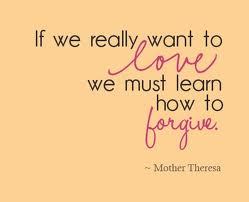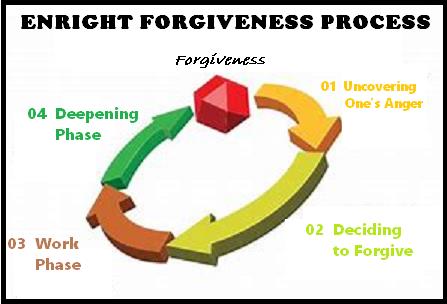How to Forgive
 Psychiatrist Richard Fitzgibbons, MD, recently said this about the work of the International Forgiveness Institute (IFI):
Psychiatrist Richard Fitzgibbons, MD, recently said this about the work of the International Forgiveness Institute (IFI):
“The research on forgiveness by Robert Enright and his colleagues may be as important to the treatment of emotional and mental disorders as the discovery of sulfa drugs and penicillin were to the treatment of infectious diseases.”
We’ve created a pathway that can teach people how to forgive if they willingly choose to do so. This pathway features 20 guideposts or steps which are organized into four distinct phases which are fully outlined in the book Forgiveness Is a Choice by Robert D. Enright, PhD.
Here is a brief description of the four phases of
Dr. Robert Enright’s Process Model of Forgiveness:
 1. Uncovering Phase
1. Uncovering Phase
During this phase the individual becomes aware of the emotional pain that has resulted from a deep, unjust injury. Characteristic feelings of anger or even hatred may be present. As these negative emotions are confronted and the injury is honestly understood, individuals may experience considerable emotional distress. Deciding on the appropriate amount of energy to process this pain while still functioning effectively is an important consideration during this phase. However, as the anger and other negative emotions are brought out into the open, healing can begin to occur.
2. Decision Phase
The individual now realizes that to continue to focus on the injury and the injurer may cause more unnecessary suffering and begins to understand that a change must occur to go ahead in the healing process. This person may then experience a “heart conversion” or, in other words, a life change in a positive direction. The individual entertains the idea of forgiveness as a healing strategy and then, commits to forgiving the injurer who has caused him/her such pain. Complete forgiveness is not yet realized but the injured individual has decided to explore forgiveness and to take initial steps in the direction of full forgiveness. An important first step at this point is to forego any thoughts, feelings or intentions of revenge toward the injurer.
3. Work Phase
Here the forgiving individual begins the active work of forgiving the injurer. This phase may include new ways of thinking about the injurer. The injured individual may strive to understand the injurer’s childhood or put the injurious event in context by understanding the pressures the injurer was under at the time of the offense. This new way of thinking is undertaken not to excuse the injurer of his/her responsibility for the offense, but rather to better understand him/her and to see the injurer as a member of the human community. Often, this new understanding may be accompanied by a willingness to experience empathy and compassion toward the offender. The work phase also includes the heart of forgiveness which is the acceptance of the pain that resulted from the actions of the injurer. This must not be confused with any sense of deserving the pain but rather a bearing of pain that has been unjustly given. As the individual bears the pain, he/she chooses not to pass it on to others, including the injurer. This is often where the challenge of a “quest for the good” is most evident. Indeed, the individual may now become ready to begin to offer goodwill toward the injurer in the form of merciful restraint, generosity, and moral love. This may or may not include reconciliation. The goodwill may be offered while at the same time taking into consideration current issues of trust and safety in the relationship between the individual and the injurer.
4. Outcome/Deepening Phase
In this phase the forgiving individual begins to realize that he/she is gaining emotional relief from the process of forgiving his/her injurer. The forgiving individual may find meaning in the suffering that he/she has faced. The emotional relief and new found meaning may lead to increased compassion for self and others. The individual may discover a new purpose in life and an active concern for his/her community. Thus, the forgiver discovers the paradox of forgiveness: as we give to others the gifts of mercy, generosity, and moral love, we ourselves are healed.
These four phases represent our understanding of the general pathway that people follow when they forgive someone who has unjustly injured them. See the complete 20 Step Process Model for details. Keep in mind that this process is not a rigid sequence and individuals may experience all or only some of the steps as they undertake the journey of forgiveness.
In addition to outlining this step-by-step approach of how to forgive in his book Forgiveness Is a Choice, Dr. Enright has recently produced a condensed version of the process in his latest book 8 Keys to Forgiveness. This hands-on guide walks readers through the process in 8 key steps, focusing on self-forgiveness as well as interpersonal forgiveness.
Find additional Information about the 20 Step Process Model in either of these books:
- Forgiveness Is a Choice by Robert D. Enright, PhD.
- 8 Keys to Forgiveness by Robert D. Enright, PhD.
Additional How-to-Forgive Resources:
- Begin your forgiveness journey by exploring Self-Forgiveness.
- Learn a step-by-step approach to Forgiving Others.
- Preserve you loving relationships or your marriage with Forgiveness for Couples.
- Help an elderly or dying person find peace with Forgiveness for Senior Citizens – End of Life.
- Become a “Peace Builder” by signing The Forgiveness Pledge.



